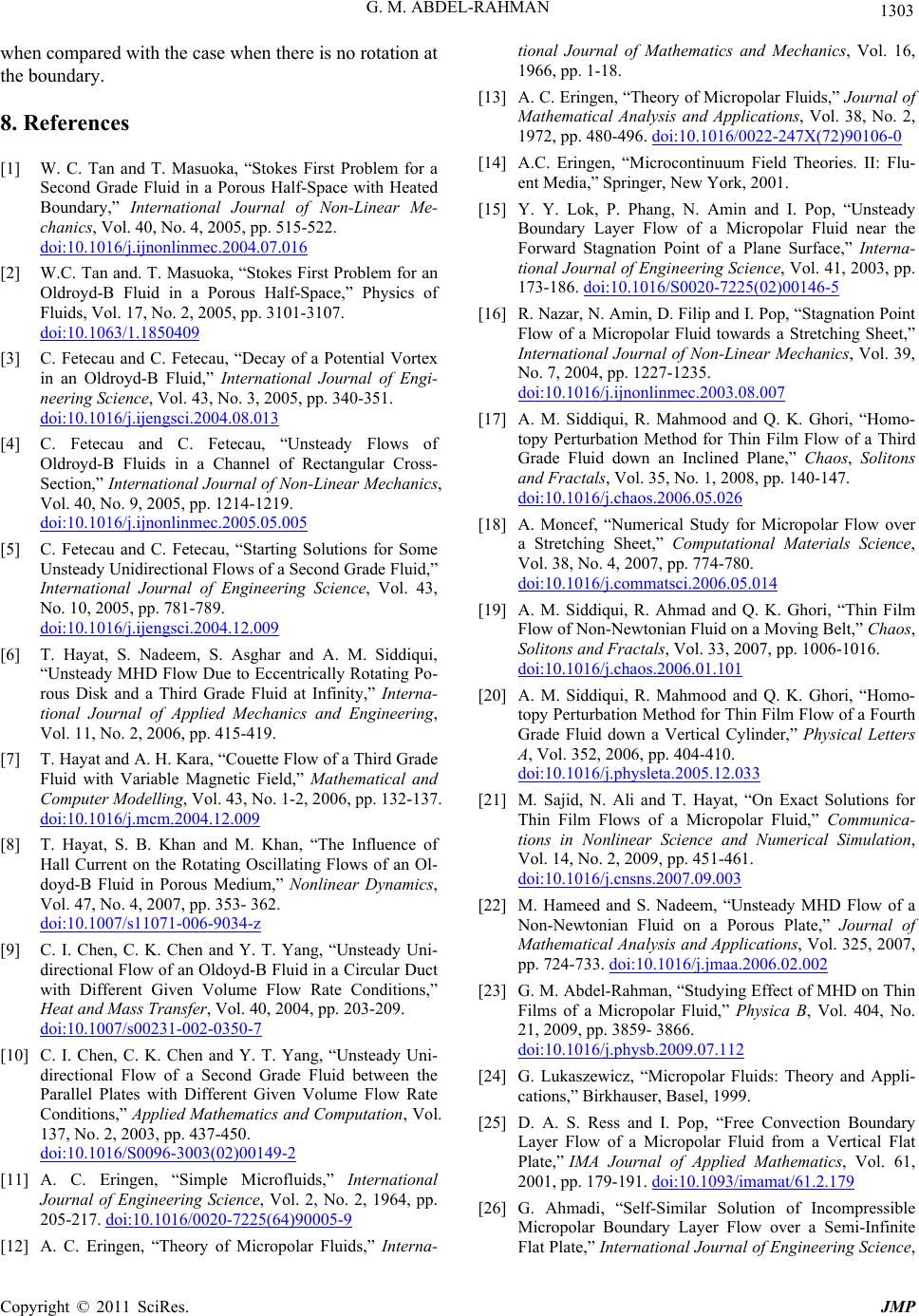
G. M. ABDEL-RAHMAN
Copyright © 2011 SciRes. JMP
1303
when comp ar ed with the cas e wh en th e r e is no ro ta tion at
the boundary.
8. References
[1] W. C. Tan and T. Masuoka, “Stokes First Problem for a
Second Grade Fluid in a Porous Half-Space with Heated
Boundary,” International Journal of Non-Linear Me-
chanics, Vol. 40, No. 4, 2005, pp. 515-522.
doi:10.1016/j.ijnonlinmec.2004.07.016
[2] W.C. Tan and. T. Masuoka, “Stokes First Problem for an
Oldroyd-B Fluid in a Porous Half-Space,” Physics of
Fluids, Vol. 17, No. 2, 2005, pp. 3101-3107.
doi:10.1063/1.1850409
[3] C. Fetecau and C. Fetecau, “Decay of a Potential Vortex
in an Oldroyd-B Fluid,” International Journal of Engi-
neering Science, Vol. 43, No. 3, 2005, pp. 340-351.
doi:10.1016/j.ijengsci.2004.08.013
[4] C. Fetecau and C. Fetecau, “Unsteady Flows of
Oldroyd-B Fluids in a Channel of Rectangular Cross-
Section,” International Journal of Non-Linear Mechanics,
Vol. 40, No. 9, 2005, pp. 1214-1219.
doi:10.1016/j.ijnonlinmec.2005.05.005
[5] C. Fetecau and C. Fetecau, “Starting Solutions for Some
Unsteady Unidirectional Flows of a Second Grade Fluid,”
International Journal of Engineering Science, Vol. 43,
No. 10, 2005, pp. 781-789.
doi:10.1016/j.ijengsci.2004.12.009
[6] T. Hayat, S. Nadeem, S. Asghar and A. M. Siddiqui,
“Unsteady MHD Flow Due to Eccentrically Rotating Po-
rous Disk and a Third Grade Fluid at Infinity,” Interna-
tional Journal of Applied Mechanics and Engineering,
Vol. 11, No. 2, 2006, pp. 415-419.
[7] T. Hayat and A. H. Kara, “Couette Flow of a Third Grade
Fluid with Variable Magnetic Field,” Mathematical and
Computer Modelling, Vol. 43, No. 1-2, 2006, pp. 132-137.
doi:10.1016/j.mcm.2004.12.009
[8] T. Hayat, S. B. Khan and M. Khan, “The Influence of
Hall Current on the Rotating Oscillating Flows of an Ol-
doyd-B Fluid in Porous Medium,” Nonlinear Dynamics,
Vol. 47, No. 4, 2007, pp. 353- 362.
doi:10.1007/s11071-006-9034-z
[9] C. I. Chen, C. K. Chen and Y. T. Yang, “Unsteady Uni-
directional Flow of an Oldoyd-B Fluid in a Circular Duct
with Different Given Volume Flow Rate Conditions,”
Heat and Mass Transfer, Vol. 40, 2004, pp. 203-209.
doi:10.1007/s00231-002-0350-7
[10] C. I. Chen, C. K. Chen and Y. T. Yang, “Unsteady Uni-
directional Flow of a Second Grade Fluid between the
Parallel Plates with Different Given Volume Flow Rate
Conditions,” Applied Mathematics and Computation, Vol.
137, No. 2, 2003, pp. 437-450.
doi:10.1016/S0096-3003(02)00149-2
[11] A. C. Eringen, “Simple Microfluids,” International
Journal of Engineering Science, Vol. 2, No. 2, 1964, pp.
205-217. doi:10.1016/0020-7225(64)90005-9
[12] A. C. Eringen, “Theory of Micropolar Fluids,” Interna-
tional Journal of Mathematics and Mechanics, Vol. 16,
1966, pp. 1-18.
[13] A. C. Eringen, “Theory of Micropolar Fluids,” Journal of
Mathematical Analysis and Applications, Vol. 38, No. 2,
1972, pp. 480-496. doi:10.1016/0022-247X(72)90106-0
[14] A.C. Eringen, “Microcontinuum Field Theories. II: Flu-
ent Media,” Springer, New York, 2001.
[15] Y. Y. Lok, P. Phang, N. Amin and I. Pop, “Unsteady
Boundary Layer Flow of a Micropolar Fluid near the
Forward Stagnation Point of a Plane Surface,” Interna-
tional Journal of Engineering Science, Vol. 41, 2003, pp.
173-186. doi:10.1016/S0020-7225(02)00146-5
[16] R. Nazar, N. Amin, D. Filip and I. Pop, “Stagnation Point
Flow of a Micropolar Fluid towards a Stretching Sheet,”
International Journal of Non-Linear Mechanics, Vol. 39,
No. 7, 2004, pp. 1227-1235.
doi:10.1016/j.ijnonlinmec.2003.08.007
[17] A. M. Siddiqui, R. Mahmood and Q. K. Ghori, “Homo-
topy Perturbation Method for Thin Film Flow of a Third
Grade Fluid down an Inclined Plane,” Chaos, Solitons
and Fractals, Vol. 35, No. 1, 2008, pp. 140-147.
doi:10.1016/j.chaos.2006.05.026
[18] A. Moncef, “Numerical Study for Micropolar Flow over
a Stretching Sheet,” Computational Materials Science,
Vol. 38, No. 4, 2007, pp. 774-780.
doi:10.1016/j.commatsci.2006.05.014
[19] A. M. Siddiqui, R. Ahmad and Q. K. Ghori, “Thin Film
Flow of Non-Newtonian Fluid on a Moving Belt,” Chaos,
Solitons and Fractals, Vol. 33, 2007, pp. 1006-1016.
doi:10.1016/j.chaos.2006.01.101
[20] A. M. Siddiqui, R. Mahmood and Q. K. Ghori, “Homo-
topy Perturbation Method for Thin Film Flow of a Fourth
Grade Fluid down a Vertical Cylinder,” Physical Letters
A, Vol. 352, 2006, pp. 404-410.
doi:10.1016/j.physleta.2005.12.033
[21] M. Sajid, N. Ali and T. Hayat, “On Exact Solutions for
Thin Film Flows of a Micropolar Fluid,” Communica-
tions in Nonlinear Science and Numerical Simulation,
Vol. 14, No. 2, 2009, pp. 451-461.
doi:10.1016/j.cnsns.2007.09.003
[22] M. Hameed and S. Nadeem, “Unsteady MHD Flow of a
Non-Newtonian Fluid on a Porous Plate,” Journal of
Mathematical Analysis and Applications, Vol. 325, 2007,
pp. 724-733. doi:10.1016/j.jmaa.2006.02.002
[23] G. M. Abdel-Rahman, “Studying Effect of MHD on Thin
Films of a Micropolar Fluid,” Physica B, Vol. 404, No.
21, 2009, pp. 3859- 3866.
doi:10.1016/j.physb.2009.07.112
[24] G. Lukaszewicz, “Micropolar Fluids: Theory and Appli-
cations,” Birkhauser, Basel, 1999.
[25] D. A. S. Ress and I. Pop, “Free Convection Boundary
Layer Flow of a Micropolar Fluid from a Vertical Flat
Plate,” IMA Journal of Applied Mathematics, Vol. 61,
2001, pp. 179-191. doi:10.1093/imamat/61.2.179
[26] G. Ahmadi, “Self-Similar Solution of Incompressible
Micropolar Boundary Layer Flow over a Semi-Infinite
Flat Plate,” International Journal of Engineering Science,